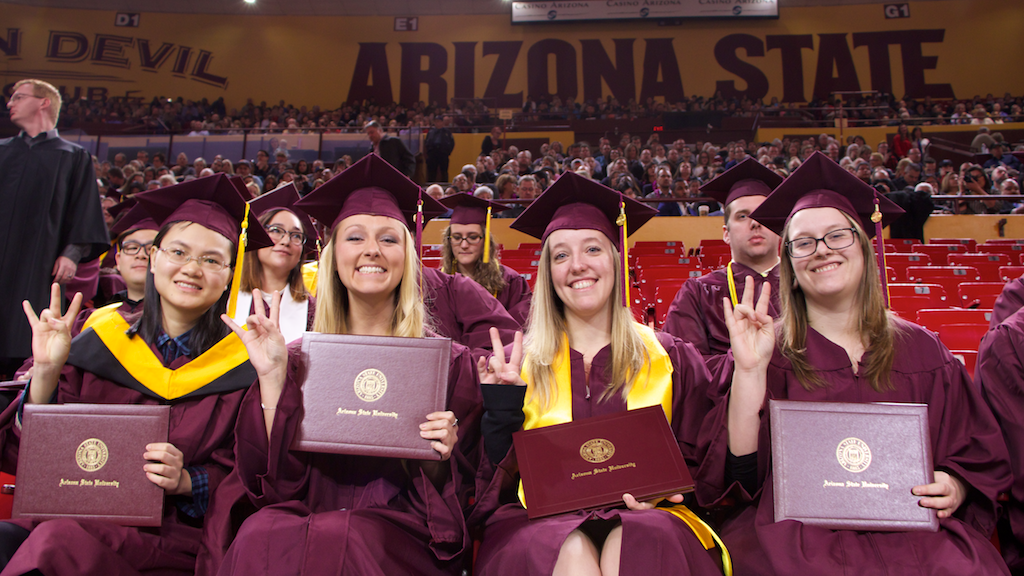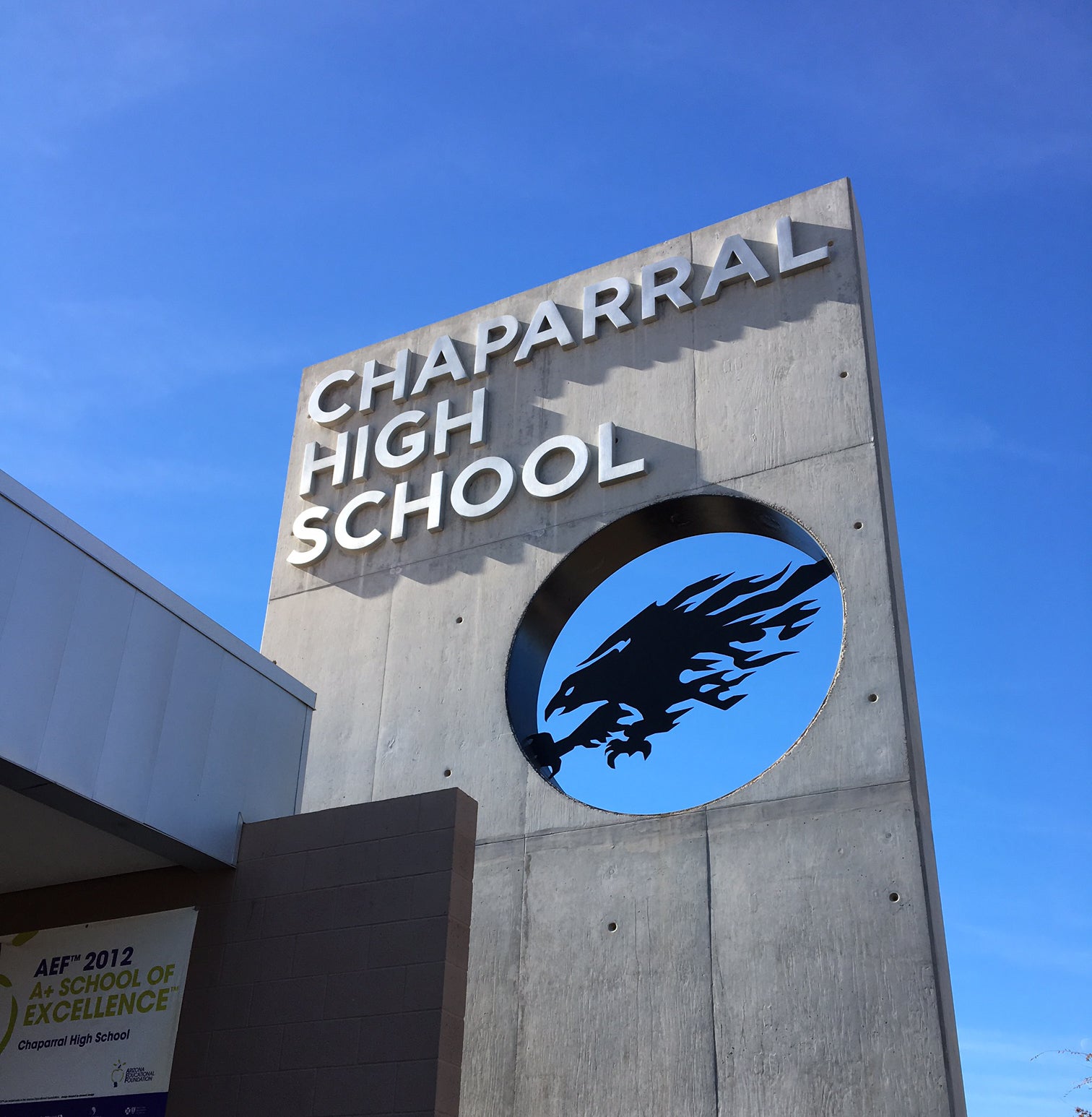First grad of new ASU math degree gets her own classroom

Krystal Yeager teaching Algebra II at Chaparral High School.
Like hundreds of other teachers, Krystal Yeager is returning to her high school math classroom after winter break.
Last fall while still attending at Arizona State University, Yeager was doing her student teaching under the watchful eye of a more experienced teacher at Chaparral High School in Scottsdale. Then in October when another teacher suddenly left, Yeager was asked to take over that classroom — by herself. Both excited and anxious, Yeager agreed.
“I figure I do it now, or I do it in two months (after graduation). And everyone here is really supportive and knows the kind of situation I got put in,” said Yeager.
Yeager obtained her emergency substitute certification and started contracted student teaching five classes of high school juniors per day, while she was still enrolled as an undergraduate mathematics major at ASU.
“She’s been thrown into the toughest situation that she could have been placed in,” said Sam Messina, a veteran math teacher who acts as her mentor and occupies the classroom next door to Yeager’s. “Teaching those Algebra II classes is tough — not only because of the challenging curriculum, but the nature of it being difficult for students.”
“I was very nervous at first about teaching,” said Yeager, “but it’s like anything that you start that's new and big. You’re anxious about it, and once you get more practice and have those little successes you become more confident.”
Yeager credits her education at ASU with helping her to be a successful high school math teacher. In December Yeager was the first graduate to earn a bachelor of science in mathematics with a concentration in secondary education through the School of Mathematical and Statistical Sciences. The program offers an alternative to the traditional path of majoring in education to become a teacher.
In December, Krystal Yeager (far right) was the first graduate to earn a bachelor of science in mathematics with a concentration in secondary education through the ASU School of Mathematical and Statistical Sciences.
“This is one of a handful of programs in the nation in which students graduate with a BS in mathematics and a certificate to teach high school mathematics,” said Pat Thompson, professor of mathematics. “The program is especially unique in that it is designed by math education researchers to familiarize students with current insights into problems of learning and teaching mathematics. We have high expectations that our graduates will become leaders within the mathematics teaching communities as well as attain advanced degrees in math education.”
Yeager liked that the mathematics degree went beyond traditional education classes.
“With this new degree, you focus more in the methods of teaching and upper-division mathematics courses,” she said. “The technology and methods courses have really helped me dig into the conceptual topics that I’ll need to know as a teacher.
“Part of the reason this degree is needed is to train teachers to do better at teaching mathematics. To be more aware of the conceptual understanding of mathematics rather than just the procedures and skills needed to get the job done. More of the understanding of why things work, how students learn — and developing ways to do things rather than just being given a formula and told to do it a certain way,” explained Yeager.
“Her math understanding is top-notch,” said Messina. “Her long-term success is going to be dependent upon her enjoying her time in the classroom, but most importantly enjoying her time around the kids.
“Because the best part of your day for a teacher should be when the kids are entering the door, not when they’re leaving.”
Yeager also likes that the new degree is a bachelor of science in mathematics.
“Having a BS in math means you can do other things with it if teaching is not right for you, or if you just want a break. It offers more flexibility than other degrees that are available,” said Yeager.
At Chaparral (pictured left) and the other high schools in the Scottsdale Unified School District, teachers use the Pathways method to teach Algebra II, which was developed by ASU mathematics professor Marilyn Carlson.
“Knowing Pathways has given me an advantage, especially coming here,” Yeager said. “The Pathways program is different. I think it is better. If the students were using some other textbook, they wouldn’t understand it so meaningfully — it wouldn’t stick for later on when they have to use it again. And I think it’s working because we had some of the best Arizona Merit scores in Algebra II.
“If you just tell someone how to do something, and they have no idea where that came from, it’s going to be hard for them to remember. It’s going to be hard for them to apply that in a new context of a problem. There’s no thinking involved in that — just mimicking and going through the motions.
“What we need are individuals who can think about things and solve problems. Not only mathematically, but in a general sense — because we have all this technology and a changing world. We need people to be able to solve problems and think about things abstractly and reason instead of just being told what to do.
“In real life, you have to figure out the problem. You have to make assumptions, and your assumptions affect your solutions. Not all the information is given to you all the time. You’re not always told, 'You’re supposed to use this formula.' That’s why it’s important for kids to be thinking instead of just being shown how to do things.
Yeager said she originally wanted to be a teacher because she liked helping people to understand.
“I like sharing ideas and helping kids be better thinkers and presenting questions they might not have thought of before,” she said.
She has some advice for other students thinking of pursuing a career in teaching.
“If you pursue math, it is difficult. But as long as you keep trying and keep working hard, that’s what makes you good at math, and that’s what makes you better,” she said.
“If you want to teach, it’s really fun. It’s hard, but it’s rewarding. And you feel like you’re actually doing something important every day. Go for it.
“I love coming here every day because it’s always something new and different. Every day some kid says something that makes you laugh, and the relationships that you build with the students and the other teachers are just fun, so I like that aspect of it. I like teaching. It’s so cliché, but I like it when the lightbulb comes on for a student. It’s a worthy endeavor.
“If you love learning and you love helping others learn, then you should do it.”
More Science and technology

ASU researcher part of team discovering ways to fight drug-resistant bacteria
A new study published in the Science Advances journal featuring Arizona State University researchers has found…

ASU student researchers get early, hands-on experience in engineering research
Using computer science to aid endangered species reintroduction, enhance software engineering education and improve semiconductor…

ASU professor honored with prestigious award for being a cybersecurity trailblazer
At first, he thought it was a drill.On Sept. 11, 2001, Gail-Joon Ahn sat in a conference room in Fort Meade, Maryland.…

